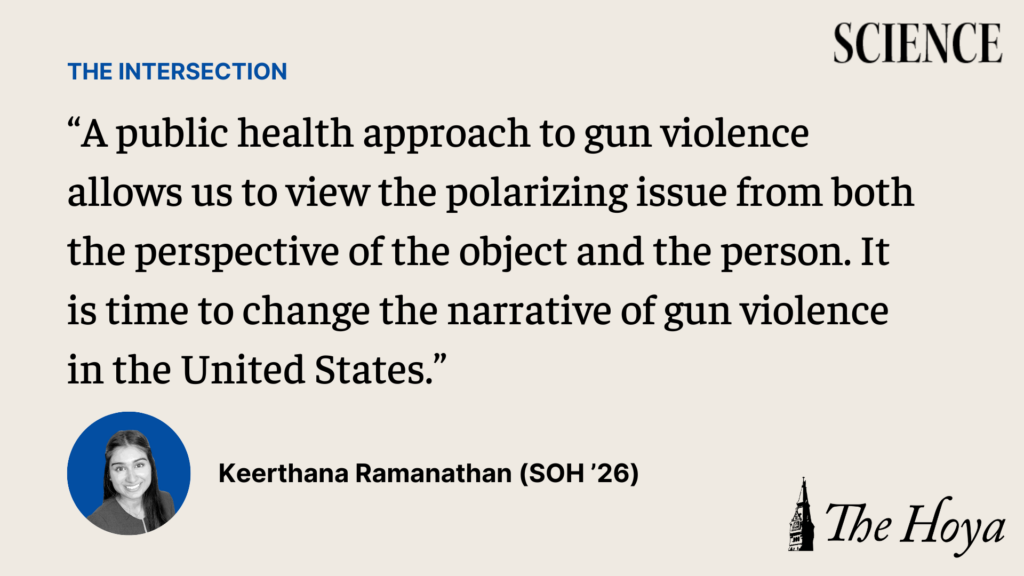Gun violence has become a fixture of American life. In 2023, as of Feb. 20, there have already been more than 80 mass shootings, including those at Monterey Park, Calif., and Half Moon Bay, Calif., and most recently, on the college campus of Michigan State University. Gun injuries and deaths increase in size and horror with every year, yet the United States continues to fail to contain this violence.
According to Dr. Megan Ranney, a physician and professor of emergency medicine at Brown University, the issue does not only lie in the argument between arming everyone or banning guns; it lies in the United States’ fundamental method in approaching the issue. It is time to start thinking about gun violence as a public health crisis, along with the politics behind it.
According to the CDC, an epidemic refers to “an increase, often sudden, in the number of cases of a disease above what is normally expected in that population in that area.” In the trail of the destruction, trauma and future injury that each act of gun violence brings with it, it is essential that activists, citizens and politicians begin viewing this polarizing issue from a medical perspective alongside its politics.
This is not the first time such an approach has been applied to other issues. At a point in time, car crashes were thought to be inevitable, but since the 1930s, car crashes and injuries have decreased by almost 60%.
Why is this the case? Experts now examine car accidents from a public health perspective, intertwining research and policy to create multifaceted solutions. Parents educated themselves on the importance of car seats, improved engineering made cars safer and the government and private organizations funded research on the issue.
However, a similar solution is not as simple when it comes to gun violence. The infamous 1996 Dickey Amendment, led largely by the National Rifle Association (NRA), has prevented the use of federal funds to advocate for gun control or research the issue. For over 20 years, Congress has prevented funding for lifesaving research. According to the Journal of the American Medical Association, gun violence research has received 1.6% of the funding and 4.5% of the research it should receive based on its mortality rate. Simply put, there are barely any statistics on injuries and deaths associated with gun violence in the United States.
Both the American Medical Association and American Public Health Association have labeled gun violence as a public health issue. Moving forward, in the face of hurdles like the lack of research and funding, gun violence must be approached through the CDC’s four-step public health approach to violence prevention.
First, it is crucial to gather sufficient data on gun violence. “The American people deserve to know who is hurt, and where, and why. We deserve to know what makes some firearm owners safe, and others not. We deserve to know which policies are effective, and which aren’t,” Ranney wrote in a Time magazine article.
This goes hand in hand with the next step in the model, which is identifying both risk and protective factors. However, in order to get sufficient government-based funding for this research, it must be a nonpartisan and collaborative effort. Furthermore, when studying risk factors, it is important to not only research policies regarding gun ownership but also include engineering research, awareness campaigns and economic reform in these studies.
Next, it is important to recognize what programs are effective and invest resources in them to scale them up in size, effectively incorporating both the third and fourth steps of the four-step public health approach to violence prevention. To do this, it is important to recognize the many ways gun violence affects people. Participants in this fight include Lock to Live, a suicide prevention program; Advance Peace, a violence interruption program; and primary care physicians, whose research aids in the fight against gun violence.
In the widespread debate of gun violence, many are often too focused on the polarity of the issue. While some argue that banning guns and increasing the rigor of background checks will reduce gun violence, others say, in a slogan popularized by the NRA, that “guns don’t kill people, people kill people.” However, a public health approach to gun violence allows us to view the polarizing issue from both the perspective of the object and the person. It is time to change the narrative of gun violence in the United States.
Gun violence in the United States is an epidemic. It is time to end it.









